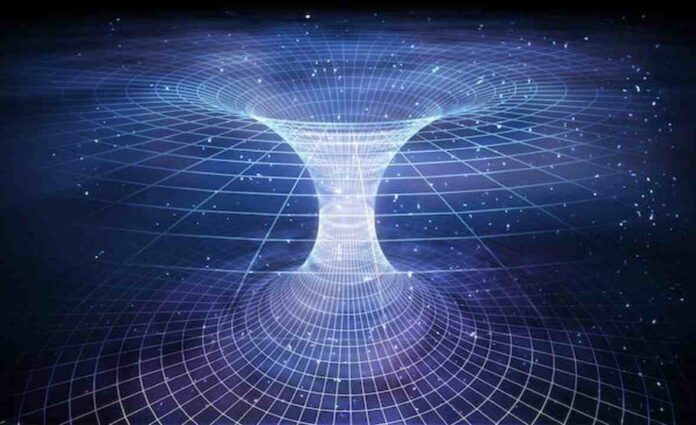Particles can become entangled in a physical process called quantum entanglement, and their connections will persist even if they are separated by great distances. Numerous investigations have been conducted into this intriguing phenomenon because of its mystery and its practical uses.
The connection between entangled particles and wormholes, which are hypothetical connections between distant regions of space-time, was recently outlined in a simulation-based model developed by College of the Holy Cross researcher Ben Kain. Physicists Juan Maldacena and Leonard Susskind have recently proposed some new ideas, and his model, which he presented in Physical Review Letters, provides a solid framework within which to test and investigate these ideas.
“I studied Dirac stars in 2019,” Kain said to Phys.org. When the Dirac equation describing fermions is coupled to general relativity, “star-like solutions” emerge in which the fermions maintain their configuration despite the pull of gravity. Of course, stars are replete with fermions, but classic depictions of them do not take this into account.
Kain previously built programming that would allow him to replicate Dirac stars with the help of two undergraduate students at the College of the Holy Cross. Other researchers found a few years ago that these Dirac systems may have wormholes if they have an electric charge.
Wormholes are tubes having two ends in separate locations and/or times, and they are solutions to Einstein’s field equations of gravity. Recent research has hinted that Dirac stars with electric charges have wormhole solutions; this would allow particles to flow through the wormholes from one side to the other.
“I thought it would be very interesting if I could simulate this wormhole and confirm if the wormhole was traversable,” stated Kain. My particular Dirac system involves two fermions, or particles, that adhere to the Pauli exclusion principle. In order for my simulations to work, the system must have spherical symmetry. The system’s total angular momentum must be zero for it to be spherically symmetric. This ultimately necessitates the singlet state,’ when the two fermions are entangled with one another.
About a decade ago, scientists Maldacena and Susskind proposed the concept of wormholes as a means of connecting entangled particles. This conjecture is both novel and controversial because it proposes a gravity-based mechanism (wormholes) to account for a quantum mechanical event (entanglement).
Entanglement, Kain explained, necessitates faster-than-light communication, but humans can’t use it to deliver signals more quickly than light. This faster-than-light communication may take place via a wormhole, as proposed by Maldacena and Susskind. To be consistent with the idea that humans can’t use the system to send communications faster than light, they also proposed that the wormhole be unpassable (i.e., people can’t travel through it).
Kain just published an article in which he introduced a novel model that may be used to investigate Maldacena and Susskind’s conjecture. The foundation of this paradigm is the computer-generated simulation of two entangled fermions sharing a wormhole connection.
After conducting the simulation, Kain discovered that in this case, black holes rapidly emerge, eventually obliterating both wormhole entrances. Due to the presence of these black holes, the wormhole becomes unable to go through.
“Since the model describes two entangled fermions connected by a non-traversable wormhole, it is a concrete model for studying Maldacena and Susskind’s conjecture,” Kain explained. “They gave their theory the term ER = EPR. Einstein-Rosen bridge (ER) is the original term for a wormhole. The initial research into entangled particles was conducted by Einstein, Podolsky, and Rosen (hence the acronym EPR). Since ER = EPR holds true in the model I examined, the two concepts are equivalent.
To investigate the potential link between quantum entanglement and wormholes, a new model is presented in this recent research. Using his model, Kain thinks scientists will be able to evaluate whether Maldacena and Susskind’s idea is right and how a wormhole could enable faster-than-light communication, a necessary condition for entanglement.
Further, “one idea I have for future works is to extend the simulations to allow matter to travel into one side of the wormhole and hence into a black hole and to travel across the wormhole,” Kain said. I’m curious to see what effect this has on the system.
Reference:
Ben Kain, Probing the Connection between Entangled Particles and Wormholes in General Relativity, Physical Review Letters (2023). DOI: 10.1103/PhysRevLett.131.101001
